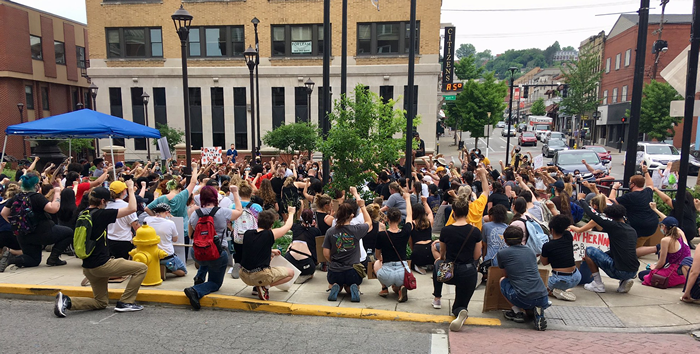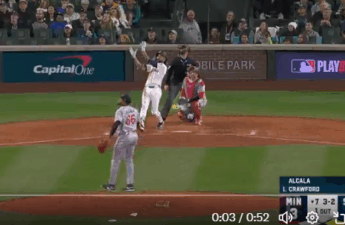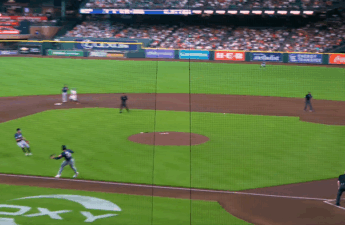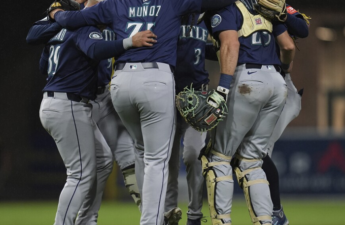
It’s been one of the most radical fortnights in American history. In the wake of the video-taped murder of George Floyd by Minneapolis police officers, a nation besieged by a global pandemic and the accompanying death and labor-market destruction has taken to the streets for continual protests demanding a reckoning with America’s history of racist oppression. As protests continue to build and swell, from major cities to tiny towns across the country, concessions by the establishment are piling up, culminating most recently in the pledge by a veto-proof majority of the Minneapolis City Council to disband their police department. For those involved in the movement, which increasingly seems to be a surprisingly large number of people, it feels like things are just getting started.
There are plenty of places you could read about this ongoing phenomenon and plenty of voices more central to the movement than mine. But I am a writer and I live in one of the more remote segments of this deeply disturbing nation: Morgantown, West Virginia, and the perspective of how things look and feel here might be a good supplement to widespread reporting on the gargantuan crowds of the coastal metropolises and the Midwestern cities where it all began. There are countless people, many of them mainstream gradualists, who have been posting their shock and disbelief at how quickly change has been achieved in the last two weeks. But even I, a devout radical, am impressed at the rallying groundswell to be found in the largest town (population 60,000 when fully enrolled with students) in one of the smallest and most conservative states in the union.
Alex and I went up to Pittsburgh for the protest on Saturday, 30 May. At that point, it didn’t really seem like the protests would make it to Morgantown and it felt like a burning necessity to be a part of the movement, not just to donate and spread the word online but to actually stand in the streets to be counted. The rate of mask-wearing was 98% or 99%, with almost everyone wearing them properly, and despite the proximity, it felt like everyone was taking the virus incredibly seriously. The number of marchers was impressive but hard to gauge in the narrow streets until we emerged to wide plazas around Duquesne University or the PPG Paints Arena, where the Penguins play. It was an overwhelming and emotional experience. In front of the Arena, there was a mysteriously abandoned police car that got its windows smashed (later video revealed this to be the work of a white anarchist who protesters argued against and who flipped off the crowd of protesters) and then was further vandalized and ultimately set on fire. At some point before the fire was set, six officers on horseback came to try to “defend” the car by posting up around it and smirking at everyone, but they eventually retreated from vitriol and the occasional tossed water bottle (again, had there just been police in the car in the first place, I can’t imagine it would have been attacked). At this point in the movement, the notion that police or pro-chaos forces would be planting cars or bricks in the streets to foment escalation of protest tactics was not well-known. I felt uncomfortable with the police car being burned, but I also understood it. At the time, of course, I had no idea that the police had essentially ensured this would happen.
We left not long after, as protest organizers began to encourage people to leave and note the direction from which riot-squad cops were planning to descend on the scene. As we were making our way back along a side street, eight officers ran up and chased many of us off, threatening to gas us and telling us to run, which proved to be an intimidation bluff when we chose not to dart into traffic to get away from them. We were several blocks away when tear gas apparently was dropped at the epicenter of the protest.
The Morgantown protests have been much tamer – Alex and I between us have been to most of the events of the week, on Tuesday, Thursday, Friday, and Saturday, though the Friday effort was a small band of folks blocking traffic in front of the courthouse on High Street. I’m trying to at least participate in the 5:30 kneel most every day, as I’ve found this ritual to be one of the most moving and impactful actions, both as a scene for the movement (see above), but also on a visceral, personal, emotional level. It’s physically uncomfortable, of course, it hurts to place one’s knee on pavement or concrete or asphalt or bricks, to position one’s weight on it and lean in, especially while simultaneously raising a fist. And this physical process, which almost universally requires several shifts and adjustments over the course of the requisite eight minutes and forty-six seconds (rounded up to ten for easy tracking most of the time), feels like a penance, like a cathartic self-flagellation, like a deposit on a debt long past due and woefully over-accrued. As humans, we are creatures of ritual and symbol, our intellect is assuaged by actions like this that remind us of the point of it all. The 5:30 kneel feels like an almost religious practice and one that could persist for many of us when the freshness of this new wave of momentum eventually diminishes or stalls.
A huge part of any protest is about the reaction it engenders. On the first Morgantown march I attended, last Thursday, I was joking internally about wanting to start a photo montage of “White people rolling their eyes at Black lives.” The march invaded the streets, blocking traffic at several intersections, swelling to occupy the area normally reserved for vehicles for minutes at a stretch. The pain of mild inconvenience, the venting of micro-annoyance by these universally pale faces, filled me with equal parts anger and shame. Contrastingly, of course, close to half of all passing or halted cars honked in rhythm at the protest, fists typically raised out of windows or even through sunroofs in echoing salute. West Virginia is a very white state and inevitably most of these supporters were also white, a reassuring expression of solidarity. Admittedly this is a college town with its typical cast of students and university employees, but the students are mostly home for the COVID-drenched summer and many townies are notoriously intolerant. There is a real sense abroad in the land, even in the rural hills of West Virginia, that this moment in history has captured a broader swath of America than ever before, illustrating both the stakes of the movement and the depth of depravity to which the police have been willing to stoop. Of course it isn’t universal, or all that close – I have rabid Trump-supporters on Facebook to remind me of that, as well as libertarians who love cops (still trying to figure them out) and then all the in-person eye-rollers who want to use the streets without considering their complicity in a system that thrives on Black death. But it still feels like I’ve been shoulder-to-shoulder with folks who’ve previously only held up a flag to wave in support, who’ve believed in the American Dream right up till they saw it violently snuffed out for a pleading man on the Minnesota macadam.
Morgantown’s own police mostly kept their distance from prior protests, allowing the streets to be blocked without involving themselves. But on Saturday, perhaps the most thoroughly organized event, which began and ended on campus, both WVU and Morgantown police were actively involved in the demonstration, escorting the marchers across town and blocking possible inroads of traffic toward the protest route on all but one street. While protest organizer Samm Norris, a powerful speaker and experienced leader, spoke at this protest about valuing having a department who sees Blacks as human and thanked MPD for their support, it was hard to feel wholly comfortable with the police presence. Largely, for me, because it felt like something that anesthetized the protest. If the goal is to disrupt the status quo, to reach out to supporters who agree but might not yet be involved, and to confront the complicit, then ensuring we march through almost entirely empty streets with nary a car in sight seems to undermine the purpose. Yes, many news outlets covered the protest and social media posts captured its size and strength, but the vibe of Saturday still felt somewhat neutered among hundreds with a police escort compared to the twenty-five of us who held down an intersection on Friday evening.
That said, part of what both police and protest organizers might have had in mind was preventing a repeat of a Thursday night near-incident, wherein a GrubHub driver pushed forward into the protesters trying to dislodge them, then pulled out a Bowie knife when many of us refused to let him through. Organizers convinced us to back off when some of us began screaming in his car, later admonishing us to keep going as a unite and not let ourselves be divided. I personally would rather we had stayed in front of his car indefinitely, but it wasn’t and isn’t my call to make. Before I got there on Friday, there was another such incident with a truck, but the truck eventually backed up without incident after revving its engine menacingly. I can understand why police would want to avoid such confrontations, but I also feel like such confrontations are or should be a goal of the movement. Not so that anyone gets hurt, of course, but to demonstrate the power of the people in the face of threats of violence.
More than anything across the last week of getting involved in this effort and the last two weeks of watching things unfold, I’ve been struck by how transcendentally minimal the main request of the movement has been. The underlying refrain of all of this, as it has been since Ferguson, is Black Lives Matter. The notion that these three words could be controversial, could be anything besides obviously universally endorsed, is a testament to just how broken and racist our society is. So perhaps it shouldn’t be surprising how quickly this movement has grown this summer, how rapidly it’s swelled and how many concessions it’s earned so far. The premise is an essential tenet of human rights: that the ability of Black people to live matters. That’s all. And it looks like acknowledging and, more importantly, enacting that reality requires dismantling many entrenched structures of our society, from police departments to educational funding mechanisms, to possibly the entire government itself. This shouldn’t be a shock, when one considers that despite its lofty rhetoric, America is a nation founded on and funded by slavery, fueled by neo-imperialism, and embedded in a global corporo-capitalist regime that thrives on oppression and dehumanization. After all, there’s a reason Fox News ran this graphic to illustrate their priorities. They’ve apologized for the graphic’s “insensitivity,” but not acknowledged that the graphic itself actually critiques our entire societal structure that overtly profits from and celebrates Black death and subjugation.
As the stock market and protest movement continue to rally in equal measure and the pandemic rebounds this summer, it remains to be seen how the next phase in our confrontation of capitalism and its corrupt oppressive systems and structures emerges. Perhaps the most profound moment in the Morgantown protests so far was a confrontation between two perspectives within the protest movement itself. State Delegate Danielle Walker, currently seeking re-election, an avid supporter of the protest, was confronted by a young Black man with whom I regularly play basketball on the WVU courts. He was simultaneously furious and eloquent, pushing supporters to leave if they weren’t ready to die for the cause, then advocating that we refuse to vote or participate in work or school until the system radically changed. He drew cheers and applause for his early comments, which slowly grew more tentative and nervous as his rhetoric escalated. Eventually Danielle regained the floor, exhorting everyone to vote as the most powerful expression of their voice, drawing more thunderous applause that eventually drowned the young speaker out. The two had a long sidebar conversation later, then he reignited and left the protest. Maybe half an hour later, a friend of his tried to fold the events together into a single narrative, landing close to where I was on the whole issue. Voting is important, he said, but is clearly insufficient. And he could understand his friend’s explosive fury, his anger at the futility of a system that always promises and never delivers.
Voting can be important, especially if there are people or ideas to vote for that are up to the radicalism of the moment. But it is not voting that has gotten Minneapolis to agree to close its police department. It is not voting that is getting the nation to confront its unjust history, much less its unjust present. It is people pushing out into the streets, standing in front of cars, in front of police in riot gear, filming it all and broadcasting to an increasingly sympathetic world. It is making America look like a nation on the brink of unrest, on the brink of rebellion, perhaps revolution, that has inspired the onset of potential radical change. Voting may be part of a balanced breakfast, to borrow from the trite corporatized memories of our youth, but it’s closer to the sugary cereal of fomenting change than the eggs, potatoes, and orange juice. Donating, standing in the streets, refusing to back down, these carry the real nutrients that power change forward.


